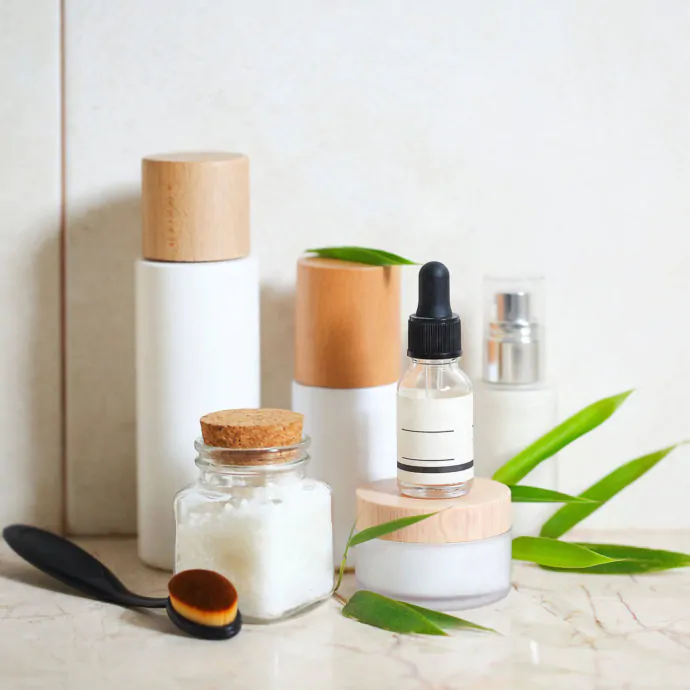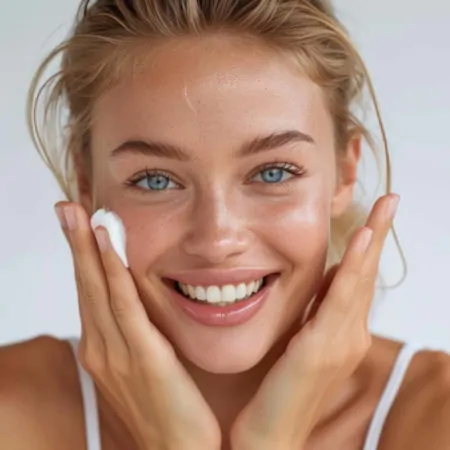Summer skincare: a complete guide to protection and recovery
Contents
- ⭐ Summer skin hydration – key tips
- ⭐ The basics of sun and UV protection for your skin
- ⭐ SPF cream: popular myths, how it works, and tips for choosing the right one
- ⭐ How SPF works
- ⭐ Common myths that need to go
- ⭐ How to choose the right SPF cream
- ⭐ Summer face care: a step-by-step program
- ⭐ 1. Cleansing – Gentle but Effective
- ⭐ 2. Toning – Not Optional, but Essential
- ⭐ 3. Hydration – The Foundation of Summer Balance
- ⭐ 4. Sun Protection – A Must Every Morning
- ⭐ 5. Repair – Nighttime Skin Recovery
- ⭐ 6. Extras – As Needed
- ⭐ Post-sun skin recovery
- ⭐ Why does your skin need recovery?
- ⭐ How to recover skin properly and effectively
- ⭐ Summer skincare products
- ⭐ Summer skincare: final thoughts
Summer is a season when your skin faces intense stress: UV radiation, high temperatures, dry air, salty water, and air conditioning all disrupt its natural balance. That’s why proper summer skincare is especially important for maintaining skin health, elasticity, and an even tone. Contrary to popular belief, moisturizing is just as essential in summer as it is in winter — the approach simply needs to be adjusted.
In this article, we’ll explore how SPF cream works, the difference between UV protection and UVB-blocking, and how to properly restore the skin after sun exposure. You’ll also find a step-by-step facial care routine, discover which summer skincare products actually deliver results, and learn how to avoid falling for marketing tricks.
Important: The recommendations in this article are for informational purposes only and do not replace professional advice. Summer skincare depends on many factors — skin type, overall health, chronic conditions, and individual sensitivity. Before introducing new products or changing your routine, it’s best to consult a dermatologist or skincare specialist.
 Summer skin hydration – key tips
Summer skin hydration – key tips
Heat, air conditioning, sun, and wind – all of these factors accelerate moisture loss from the skin’s surface, making it more vulnerable to irritation, flaking, and premature aging. That’s why hydrating your skin in summer is not just a cosmetic whim, but the foundation for maintaining its health and comfort. It’s not only about using a cream, but also about knowing how and when to apply it. Below are dermatologist-backed tips and care practices suited for hot climates:
-
Choose lightweight, water-based moisturizers. Gels, fluids, and emulsions absorb quickly, don’t overheat the skin, and don’t create a “film” that hinders thermoregulation.
-
Look for ingredients like glycerin, hyaluronic acid, aloe vera, and niacinamide. These not only hydrate but help retain moisture within the skin.
-
Apply moisturizer to slightly damp skin. This enhances the effect – humectant molecules “grab” water and hold it in the epidermis.
-
Avoid heavy, greasy textures. Oils and thick creams can create a greenhouse effect, leading to breakouts and a sticky feel.
-
Use thermal water or a hydrating mist throughout the day. But always seal them in with a cream or serum – otherwise, they may increase moisture evaporation.
-
Monitor air humidity levels. Air conditioners and dry environments harm the skin. If possible, use a humidifier – especially at night.
-
Drink enough water. A classic but crucial point: external hydration works much better if the body isn’t dehydrated from within.
Consistent and proper hydration during summer not only helps prevent dryness but also builds a strong barrier against external aggressors like sun and pollution. In other words, you’re not just caring for your skin – you’re strategically strengthening it.
The basics of sun and UV protection for your skin
The sun is a source of life and good mood, but for your skin, it can be a real challenge. Even if you don’t sunbathe intentionally, the cumulative effects of UV radiation occur daily – during a walk, a commute, or even just sitting by a window. And if sun protection isn’t part of your daily routine, your skin will “remember” that. The consequences build up over time: pigmentation, photoaging, weakened skin immunity, and an increased risk of skin cancer.
It’s important to understand that UV protection isn’t just about SPF. It’s a whole system of habits and strategies that work together like a well-tuned mechanism:
-
Avoid sun exposure during peak hours (10 AM to 4 PM). This is when UVB rays are most intense, and even brief exposure can cause micro-burns.
-
Choose tightly woven, light-colored clothing. These fabrics reflect sunlight more effectively and provide a physical barrier against UV radiation.
-
Wear wide-brimmed hats and sunglasses. The skin around your eyes is one of the thinnest and most sensitive, and it’s often where signs of photoaging appear first.
-
Don’t rely solely on shade. UV rays reflect off water, sand, asphalt, and even glass — sun protection is essential even on cloudy days.
-
Incorporate antioxidants into your skincare. Vitamins C and E, ferulic acid, and green tea help neutralize free radicals caused by UV exposure and strengthen the skin’s natural defenses.
-
Avoid photosensitizing ingredients. Some essential oils (like bergamot or citrus), acids, and retinoids increase the skin’s sensitivity to sunlight — use them cautiously or only in the evening.
Effective sun protection begins with the understanding that sunlight is a factor to manage wisely. Only then can summer skincare truly be effective — not just cosmetically, but in preserving your skin’s long-term health and vitality.
 SPF cream: popular myths, how it works, and tips for choosing the right one
SPF cream: popular myths, how it works, and tips for choosing the right one
SPF creams have long been surrounded by controversy: some see them as a lifesaver, others as “chemicals you’d better avoid.” As usual, the truth is more nuanced, scientifically grounded, and far more interesting. To truly understand how sun protection works, it’s essential to break down what SPF is, how it works, and why it doesn’t make you invincible.
How SPF works
SPF (Sun Protection Factor) is a measure of protection against UV rays that cause sunburn. For example, SPF 30 theoretically allows you to stay in the sun 30 times longer before reddening than without protection. But keep in mind: it doesn’t block all radiation — it simply slows the rate of damage.
Physical (mineral) filters, like zinc oxide or titanium dioxide, reflect and scatter UV rays like tiny mirrors. Chemical filters (e.g., avobenzone, octinoxate) absorb UV energy and convert it into heat. Most modern SPF products combine both types for broader and more stable protection.
Common myths that need to go
-
“SPF 50 is twice as effective as SPF 25.” Not really. SPF 25 blocks about 96% of UVB rays, while SPF 50 blocks about 98%. The difference is minimal, especially if applied unevenly or too thinly.
-
“If my foundation has SPF, that’s enough.” Usually false. To reach the labeled SPF protection, you’d need to apply 1.5–2 ml on the face — much more than typical makeup application.
-
“You only need SPF at the beach.” UV radiation is active daily. UVA rays — responsible for photoaging — penetrate deeply and pass through windows.
-
“Chemical filters are toxic.” Scientific reviews do not support this claim. In regions like Europe and Japan, UV filters must pass some of the world’s strictest safety tests before being approved.
How to choose the right SPF cream
Here are the key points to consider:
-
Choose a cream labeled “broad-spectrum” to protect against both UVB and UVA.
-
For daily city use, SPF 30 is sufficient. For the beach, driving, high altitudes, or post-laser care, go with SPF 50.
-
Look for light textures — gel-creams, fluids, and emulsions are more comfortable in summer than heavy creams.
-
Ingredients like aloe vera, panthenol, and antioxidants not only protect but also soothe and nourish.
-
Always check the expiration date, and store the product away from sunlight — oxidized filters lose effectiveness.
-
Apply enough: 1/4 teaspoon for the face, and reapply every 2 hours in direct sun.
A good SPF cream won’t make your skin flawless overnight, but it will protect it so you can look and feel your best — not just today, but 10 years from now.
 Summer face care: a step-by-step program
Summer face care: a step-by-step program
Summer isn’t just about sunshine and ease—it’s also a time of skin stress: increased sweating, excess sebum, clogged pores, heightened sensitivity, and dehydration. To keep your skin glowing and healthy during this season, you need more than just a basic routine. You need a thoughtful, summer-adapted facial care system. Below is a step-by-step plan that combines science, logic, and comfort.
1. Cleansing – Gentle but Effective
In summer, skin gets dirtier and overheated more quickly, so cleansing should be regular but non-aggressive.
-
Morning: Use a mild foam or gel cleanser with a pH of around 5.5.
-
Evening: Opt for double cleansing (cleansing oil or micellar water + foam). This is especially important if you wear SPF or makeup.
-
Avoid brushes and scrubs – microdamage + sun = hyperpigmentation.
2. Toning – Not Optional, but Essential
A well-chosen toner restores the skin’s pH and preps it for hydration.
-
Look for toners with niacinamide, panthenol, or green tea extract.
-
Avoid alcohol-based formulas – they can dry out the skin and cause irritation.
3. Hydration – The Foundation of Summer Balance
Summer hydration is all about texture, ingredients, and timing.
-
Morning: Use a lightweight gel or fluid with hyaluronic acid, betaine, or aloe vera.
-
Evening: Go for something slightly richer, like an emulsion or light cream with antioxidants. Apply to damp skin for enhanced absorption.
4. Sun Protection – A Must Every Morning
No matter how great your routine is, it’s useless without sun protection.
-
Apply broad-spectrum SPF daily, even on cloudy days.
-
Important: apply sunscreen as the last step of your morning routine, 15–20 minutes before going outside.
5. Repair – Nighttime Skin Recovery
Even with protection, UV exposure still stresses the skin. Nighttime is for healing and support.
-
Use serums with vitamin C, ferulic acid, or niacinamide.
-
After heavy sun exposure, soothe the skin with aloe vera gel, cucumber extract, or panthenol.
Skin repair after sun exposure is not a luxury—it’s cellular-level protection.
6. Extras – As Needed
-
1–2 times a week: Use an enzyme peel or clay-based mask.
-
If needed: spot treatments for breakouts, lightweight serums, or concentrates.
Summer doesn’t require “minimalism for the heat.” It requires a smart approach. The best summer face routine isn’t 10 different products—it’s a few key steps that work in synergy to cleanse, hydrate, protect, and restore your skin. When done right, even in 30°C heat, your skin will thank you—not with flaking and irritation, but with a healthy glow and lasting comfort.
Post-sun skin recovery
Even if you strictly follow sun protection rules, your skin still faces the consequences of UV stress during summer: microinflammation, dehydration, weakened skin barrier, and accumulation of free radicals. That’s why post-sun skin recovery is a vital part of a thoughtful skincare routine. In the evening, when UV activity drops, the skin begins its regeneration process. What you give your skin during this time determines not just how it looks tomorrow, but years from now.
Why does your skin need recovery?
Ultraviolet radiation breaks down collagen, depletes antioxidant reserves, damages cell DNA, and weakens the lipid barrier. Even without visible sunburn, oxidative stress occurs—a slow but cumulative aging process. Your task is to soothe, hydrate, nourish, and stimulate regeneration.
How to recover skin properly and effectively
-
Start with cooling and hydration. After sun exposure (beach, picnic, sports), wash with cool water and apply a gel with aloe vera, panthenol, or cucumber extract to give your skin a break. These ingredients reduce redness, burning, and swelling.
-
Use a hydrating serum or mask. Ideally with hyaluronic acid, betaine, or polysaccharides to restore the skin’s moisture balance and prevent peeling.
-
Rebuild the barrier. Choose creams with ceramides, squalane, fatty acids, and niacinamide. These strengthen the skin’s protective layer and speed up healing.
-
Apply antioxidants — both topically and through diet. Night care can include vitamin C, resveratrol, or coenzyme Q10 to fight free radicals and slow photoaging. In your diet, aim for berries, leafy greens, nuts, and green tea.
-
Avoid harsh cosmetics. Put retinoids, acids, scrubs, and peels on hold until your skin is fully balanced again. These can increase sensitivity to UV and worsen irritation.
Consistent and mindful post-sun skin recovery is an investment in your skin’s health and longevity. When you treat skincare not as a chore but as a conscious act of self-care, your skin responds in kind—with smooth texture, even tone, and no visible signs of stress.
Summer skincare products
Looking for specific products for summer skincare based on skin type and purpose? Below is a detailed guide by product categories, formats, and key ingredients, presented in a table format.
| Care Category | Product Format | Key Ingredients | What to Look For |
| Cleansing | Foam, gel, enzyme powder | Green tea, zinc, centella, allantoin | Sulfate- and alcohol-free, double cleansing in the evening |
| Toners & Essences | Spray, splash toner, liquid toner | Hyaluronic acid, panthenol, betaine | pH restoration, refreshing and moisturizing effect |
| Serums | Ampoules, gel or water-based formulas | Vitamin C, niacinamide, antioxidants | Morning – protection, evening – recovery |
| Moisturizing | Fluid, gel, emulsion | Squalane, glycerin, ceramides, aloe vera | Light texture, deep hydration without greasiness |
| SPF Protection | Cream, fluid, stick | Mineral/chemical filters, antioxidants | Broad-spectrum, at least SPF 30, water resistance |
| Masks | Sheet, gel, overnight | Aloe vera, snail mucin, chamomile | Post-sun – soothing, night – recovery |
| Skin Recovery | Gel, cream, balm | Panthenol, niacinamide, ceramides, calendula extract | Fragrance-free, non-comedogenic, soothes irritation and redness |
Now you have at your fingertips a clear and logical checklist of which skincare products are truly worth including in your summer routine – and why. Summer brings specific challenges, and choosing the right cosmetics allows your skin to maintain its health, comfort, and natural glow.
 Summer skincare: final thoughts
Summer skincare: final thoughts
The summer season is a real endurance test – for both the body and the skin. Heat, sun exposure, sweat, dust, and dramatic temperature shifts between air-conditioned rooms and the outdoors all make the skin more vulnerable, even if it’s not usually sensitive. But the key to getting through this season successfully doesn’t lie in expensive jars or fleeting trends. It’s in understanding what’s really happening with your skin and applying a systematic approach.
Summer skincare rests on four pillars:
-
gentle cleansing
-
thoughtful hydration
-
proper sun protection (including SPF cream)
-
timely after-sun recovery
Add seasonal adaptation of textures and ingredients, and you’ve got a complete, functional protocol.
A good summer facial routine isn’t about burdening your skin – it’s about care, grounded in knowledge.
When you choose summer skincare consciously – based on your skin’s needs rather than marketing claims – summer becomes not a challenge, but an opportunity for your skin to shine at its best: glowing, healthy, and well-protected.
If you’d like to entrust your summer skincare to professionals, the LaserVille mono-salon network offers personalized programs and advanced laser hair removal technologies – ensuring comfort and safety for all skin types, in any season!


 Summer skin hydration – key tips
Summer skin hydration – key tips SPF cream: popular myths, how it works, and tips for choosing the right one
SPF cream: popular myths, how it works, and tips for choosing the right one Summer face care: a step-by-step program
Summer face care: a step-by-step program
 Summer skincare: final thoughts
Summer skincare: final thoughts




























No reviews